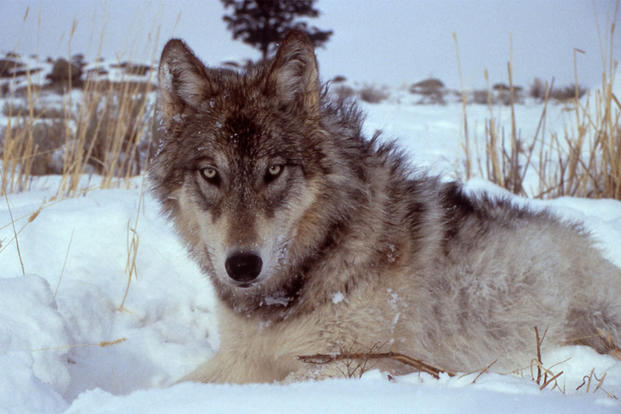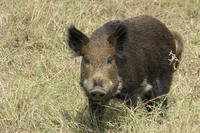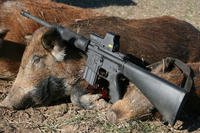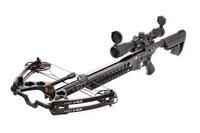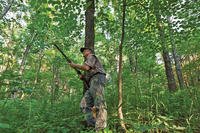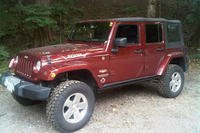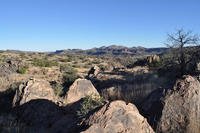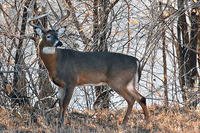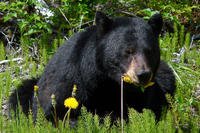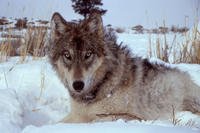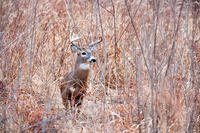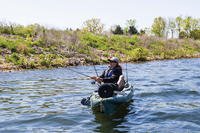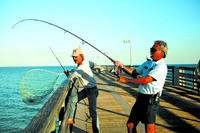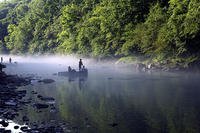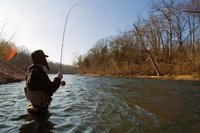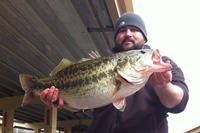I'm standing with my rifle resting on my shooting sticks, scanning left, right, then left again. I'm looking in the right direction for a change. I see snow falling from a low spruce branch and then a great big wolf head magically appears no more than 30 yards away. It's huge. I mean, the face of the wolf looks as big as a 30-pound pumpkin! It doesn't see me; it's looking across the power line. Slam dunk; I look through the scope, get the crosshairs on the wolf's shoulder, squeeze and, click…misfire!
The wolf looks at me and simply vanishes. I'm thinking, "Okay, don't panic, jack another shell in and stay ready, it's just a misfire and the wolf still wants to cross the power line." Then he's standing in the middle of the power line, glancing over at me. I'm wondering how he got there, and conclude that he just materialized out of thin air. No time to ponder; the rifle is still on the shooting sticks and I'm rock solid. I put the crosshairs on his shoulder, which is about 90 yards away, take control of my breathing and squeeze off a round. CLICK! The wolf whirls and is gone. I jack another shell in and take a "rabbit shot." BOOM! The damn thing goes off, and the echoes cover up the words I'm yelling to the north wind.
Off To A Fast, Cold Start
It was 20 degrees when I left Ohio, 8 degrees in Fort Erie, -13 in New Liskeard when I stopped for supper, -18 in Cochran and -25 in Kapukasing, Ontario, a town of 9,500 that was my final destination. This was definitely the coldest weather I've ever tried to hunt in. I was in Kap, as the locals call Kapukasing, to hunt timber wolves. Kap is known as a place of extremes, mostly frigid extremes. General Motors has a cold-weather testing facility there, which is a clue to how cold it really gets in these parts.
I didn't know too much about the wolf hunt other than it was going to be different from how people usually hunt wolves. Most hunters get a wolf as a bonus on a big-game hunt, or by watching bait. I found the details about this hunt on a website, AccurateReloading.com, where someone had started a thread asking about wolf- hunting outfitters.
One suggested destination, KapRiver Retrievers and Outfitters, jumped out at me as it was in Ontario, within fairly decent driving distance. I sent an e-mail requesting more information, and got a phone call from Peter Martin of the KapRiver crew. He spent 20 minutes explaining his wolf hunts. Guides scout until they find a set of fresh tracks, then drive the wolf toward the hunters — in sub-zero weather, with lots of snow — using four-wheel-drive trucks and snowmobiles. Everything except the sub-zero weather and lots of snow sounded interesting to me. Still, the next day I booked a five-day, mid-February wolf hunt to northern Ontario. It sounded like just the adventure I was craving. Little did I know how much adventure I would experience.
I arrived in camp late the evening before the first day of hunting, said a few howdies and eventually snuggled in under the warm blankets and enjoyed a dreamless sleep. I awake at 6 the next morning, put on a few clothes and go to the kitchen for a much-needed cup of coffee and more friendly fellowship. That's when Peter says, "There's toast and cereal. Eat fast. We leave in 20 minutes." So much for a leisurely breakfast, and my hunting gear is still in my truck to boot. Not wanting to hold anybody up, I rush to get my gear, pull on several layers of hunting clothes and meet the other hunters and guides with about a minute to spare. I have no idea what to expect, but whatever it is, is coming at me fast.
Wolves and Moo-Moo Cows
Peter Martin not only hunts wolves, but he is also a licensed chiropractor and breeder of world-class Labrador retrievers. Martin has helped more than 250 hunters tag wolves and has taken over 50 himself. He knows wolves! You can actually see the man go into "wolf mode;" so focused is he on outsmarting the wolf that everything else is a distraction.
Martin's approach to wolf hunting is fairly systematic. First he finds blocks of timber that range in size from 50 to 500 acres. Each block must have snowmobile access such as a logging road, power line, haul road, snowmobile trail or river. Then comes the bait: recently deceased and frozen dairy cows, cut into manageable 50- to 250-pound chunks. Martin uses lots of bait, over 100 tons of it a year. You read that right: over 200,000 pounds of dead cows a year!
One or more baits are put into each block before a hunt with the intention of drawing wolves into the kill zone. Hunters travel from bait to bait to check for sign that indicates wolves are feeding. If there's action, the block is circled on snowmobile. If there are wolf tracks going in, but not coming out, the trap is set. Martin and his guides block off three sides. They do this by putting transistor radios along the trails and talking over them to each other, or riding back and forth on snowmobiles. The jaws of the trap, figuratively speaking, are the hunters, who set up to cover the fourth side of the block — the "exit" for the wolves. Of course, no setup is perfect, and the hunters' part in the affair often goes awry. Time after time, day after day, Martin and his men push wolves toward hunters who either get a shot, don't get a shot, never see the wolf, miss, or — like me — misfire.
So it goes on our hunt. We load up in trucks and drive to a country road where the snowmobiles are unloaded. Martin asks if anyone knows how to drive a snowmobile. I drove one 30 years ago, so that's enough to elect me as a designated driver. We ride down a trail; Peter stops, looks around and motions me to get off my snowmobile. He backs up a bit toward me and says, "Watch this trail; if a wolf comes, kill it." Just like that, and then he's gone, presumably to join the drivers.
Now I'm in the middle of northern Ontario, where it's 18 degrees below zero, wondering why I'm in this particular spot. There are miles and miles of trails radiating in all directions, but I'm watching a 200-yard stretch of one. Before we left the house, Peter gave each of us a two-way radio. I dig mine out, turn it on, and then it occurs to me that I wish I hadn't drunk so much coffee. It's cold, really cold; hooray for chemical handwarmers. After a bit, a big white snowshoe hare hops up on the trail. I wonder if they taste like a cottontail, then decide my .30-06 is too much gun for hares. After an hour or two, Peter picks us up to head for the next bait post, which turns out to be a coyote haunt. You might want to think twice if you get the chance to shoot a coyote in Ontario. If you do drop one, you have to use your wolf seal on it, and then you have to go buy another $247.66 seal. You're only allowed to purchase two seals, so you might want to take a pass on the coyotes. Of course, that might be all that you get a crack at. That's how it went the first two days. We had a wolf cross right in front of one of the guides as he went to reposition another hunter, and they almost ran over it with the snowmobile.
It Finally Happens
Then comes Wednesday. Martin runs the perimeter of a big block, comes back to the truck and motions for to us to get ready. Another hunter, Bill, is on the snowmobile with the outfitter and I am in the "Trailer From Hell." You haven't experienced real misery until you let Peter Martin drag you around the bush in that thing! Peter drops Bill off and we ride farther down the power line. He stops and deadpans, "The animal should cross right here." Then, in typical Martin fashion he's gone and I'm alone. I stand there trying to figure out what is so special about this particular stretch. It looks exactly like the other miles of power line cuts and empty country. By now, though, I'm not into questioning Martin's stand choices. It's uncanny how he knows where wolves will cross.
I get my shooting sticks set up —again — kick some snow out of the way, and prepare for a wait of indeterminate duration. My mind starts to wander — what kind of sandwich did Peter make for our lunch today … hope he didn't put another pickle on it, I almost chipped a tooth on a frozen pickle yesterday! One of the things Martin keeps harping on is to stay focused. To be honest, I tried, but before long I start wondering about supper, then about a cup of coffee and how good it would be.
I'm almost smelling the coffee, but then the radio crackles to break the silence. It's the guide: "I just pushed a wolf from his bed and he's headed south." I check my compass — south — that's away from me. I'm west, Bill's northwest and Brian's north. South is no good, south is bad. Come on, Ryan the Guide, turn him back! The radio starts talking again, "You guys get ready! Now he's moving west." That's good; I'm west, come on wolf! Forget lunch; forget the coffee.
One's Greatest Fear Realized
And then the wolf comes by me and I blow the chance, or my gun does. Peter comes flying up on the snowmobile and I tell him what happened. We're pretty sure snow got into the action, melted, then refroze in the hole of the bolt face. The firing pin didn't hit anything but ice. Rotten luck, but nothing that can't be fixed with a handwarmer. I'm pretty excited. I actually saw my first wolf in the wild, a rare treat for anyone. There's no doubt in my mind that, had the rifle gone off, I would have killed a wolf.
We keep hunting, checking baits and setting up ambushes. Bill's chance came Thursday, but it was a long miss. On Friday, a guide has a wolf moving, but it slips through a crack in the trap (someone said somebody fell asleep, but it's strictly a rumor). The wolf finds the only weak spot — maybe he hears snoring — and makes his escape, but not before trying to make Ryan dirty his shorts. The wolf jumps from behind a tree close enough to land on the back of the guide's snowshoes! We start to reset the trap and one of the snowmobiles breaks down — a minor inconvenience to Martin, who finishes setting everyone in place with one machine. You almost have to feel sorry for the wolves because it seems that Peter knows what they are going to do before they do it. Martin's only weak links in the traps are the human hunters, who tend to make a lot more mistakes than the wolves do.
Another day, Peter picks me up and takes me to the second snowmobile, then drops me off. He points off in the distance and instructs me to "Go up there, then go over that way, out to the road, and give the snow machine to Ryan. Then hike to where you were set up this morning." Just like that. I turn around to ask Martin exactly where "there" is but he's already gone, on a mission to put another trap together. I jump on the sled and give it the gas, going up a hill, thru the woods, over logs and saplings until I get into an open area and start breathing again. I'm following a snowmobile trail, hoping it takes me to Ryan, which it does. "Am I getting too old for this?" I ask myself as panic sets in. But then my next thought is, "I wonder if they'll let me come back next year?"
I'll Be Back!
When all was said and done, I didn't shoot a wolf, yet I wouldn't trade those days in the northern Ontario bush for anything. What an adventure, what a grand, thrilling experience to hunt timber wolves on a snowmobile in sub-zero weather! If you crave adventure, you owe it to yourself to try this. Otherwise, sit by the fire and read a book, then maybe another one. But if you do decide to go wolf hunting, I promise you that you'll be hooked, as are most of the hunters who visit Martin's came and who come back year after year.
I'm thinking about next winter as we pack up and prepare to head out on Saturday morning. After saying my goodbyes, I point my truck south for the 16-hour drive. The thermometer in the truck says -23, warms to -15 in Cochrane, -2 in New Liskeard, a blistering 11 at North Bay, a balmy 23 degrees at Fort Erie and a positively sub-tropical 28 at Leetonia, Ohio. It felt so warm I even washed the road grime off my truck after I unpacked. I'll never look at cold weather the same.
